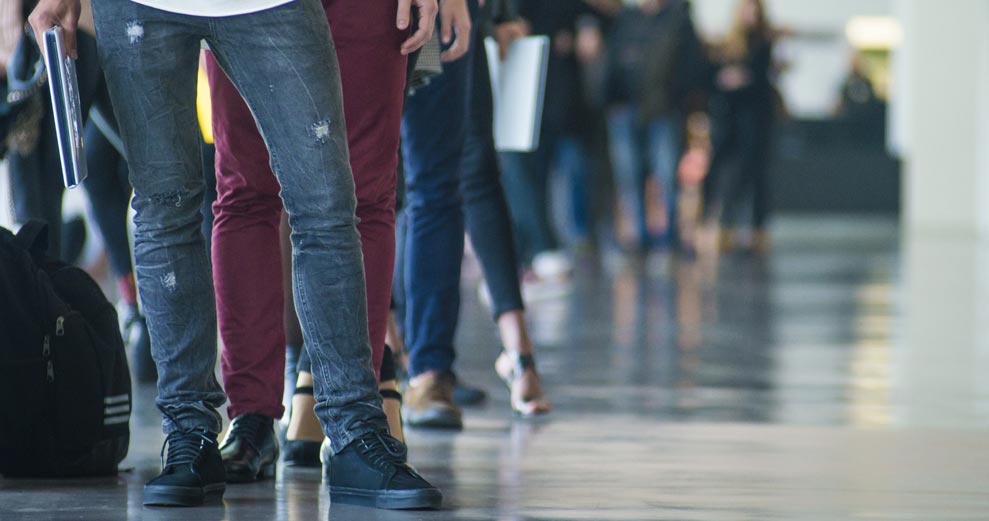How to Behave While You Wait:
Waiting in line—for anything—can be miserable, causing people to lose their mind. According to Citylab.com, “Americans spend 37 billion hours waiting in line every year.” Teachers who lead students on trips question how to monitor their students’ behavior and decrease their stress level as they stand in a line at airports, concerts, museums, restaurants, and a plethora of other places.
First and foremost, teachers need to accept that waiting in line is unavoidable and inevitable; the attitude the teacher and students have toward the wait, however, can make the difference. In general, people feel waiting is fair, but when there’s no viable reason, it feels intolerable for those in line.
We value our time and don’t want to waste it.
Sometimes, we voluntarily wait in line for the newest foreign film movie release, the grand opening of a new German restaurant, tickets to a Vienna Boys Choir concert, or entry into an attraction like the Tower of London or Empire State Building. In these instances, teachers and students want to wait—it creates a buzz and gives them bragging rights. When students visualize the experience, the wait will be more pleasurable as they focus on the enjoyment ahead. In these cases, “The end benefits seem to outweigh the cost of lining up,” according to Richard Larson, a professor at MIT who has been studying the science of lining up. In simpler terms: When we see value in what we’re waiting for, we don’t mind the wait and are willing to endure the lines.
But what happens when students start to get restless and waiting becomes stressful and annoying? Teachers must have a plan in place, to prevent students from getting unruly. The online magazine Mental Floss offers suggestions to make waiting easier.
Incorporate music. Prior to departure, teachers or students could download music onto their telephones and play it, as needed, being mindful of others waiting in line. On a People to People trip in Australia, the destination manager played typical Aussie songs as we waited to enter Sydney Opera House. The music calmed the students and reminded them of their unique adventures in Australia.
Bring something to pass the time. I always pack several decks of playing cards or compact travel games to use on the bus or when waiting in lines. When students focus on a game or activity, time seems to pass quicker. Their busyness distracts them from the reality of a long wait or lengthy line. This is also a good time to ask students about what they have learned or are about to experience.
In France, our group had a long wait before going up the Eiffel Tower. Paula, one of the teachers, created a quiz about the sights we’d visited in Paris—Arc de Triomphe, the Louvre, Montmartre, Palace of Versailles, Notre Dame Cathedral and, of course, the Eiffel Tower. When a student answered a question correctly, they received a small token; a trinket Paula purchased as we traveled throughout France. This activity helped pass the time, reinforced learning and provided a chance to earn souvenirs.
To me, the easiest thing to do when waiting in line is make new friends. Think about it: Those in line already have in common the mere fact that they’re in the same line. Take advantage of this connection and commence conversations! One never knows what connection you may have with fellow linegoers or how those connections may benefit you.
Years ago, four high school friends and I visited New York City. We had tickets to see a taping of the TV show Live with Kelly and Michael. Despite receiving tickets in advance, we had to wait in line, outside, for an hour before we could enter the studio. My friends were not happy about this; I saw it as an opportunity to interact with others, because I love meeting new people and learning about their lives. I worked my way down the line, asking each person questions. Finally, we were given permission to enter the building.
My friends and I had never seen this show before and were unaware that each day, one member of the studio audience was selected to be the guest dancer. Prior to the start of the live show, four audience members are chosen to come onstage and showcase their dance moves. Guess who was the first person selected to “audition?” After the four participants danced, the audience selected the winner. When the producer held his hand over my head and asked audience members to vote for their favorite dancer, 95% of the audience voted for me. Why? They felt a connection to me because of my random conversations with them while waiting in line. Who knew that a long one-hour wait in line would lead to a coveted three minutes of national TV fame?
Teachers and students need to utilize mindfulness. Students can focus on their breathing to relieve anxiety and stress. Deep breaths and muscle relaxation help decrease stress and keep students calm. Long lines also give students ample opportunities to practice patience and self-control. Teachers should remind students to concentrate on how quickly the line is moving versus the length of the line. They can also give updates, if they have key information on the delay, and estimates on the wait time. According to Mental Floss, “Uncertainty, anxiety and boredom make waiting feel longer but often, people overestimate the time they are waiting.”
Teachers and tour guides should adhere to the model Patch Adams—an American physician and clown who travels the world to bring humor to orphans, patients and other people—utilizes when waiting in lines. He said, “Waiting in line is a great opportunity to meet people, daydream or play.” By following his example, teachers will reduce student stress and guide them in how to stand in a queue without losing their minds.
Written by Julie Beck, Contributing Writer for Teach & Travel.
This article originally appeared in the January 2020 issue of Teach & Travel.





